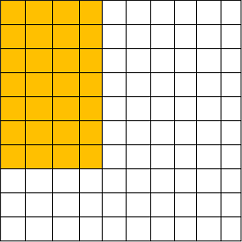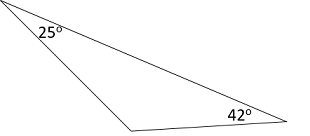The 5th Grade MAP Growth test assesses student abilities across subjects to track their progress. A strong performance can open doors to gifted programs and future academic success.
This adaptive test covers math, reading, language, and sometimes science. It adjusts difficulty based on student answers, providing valuable insights.
This page explores sample questions from math, reading, and language to help your child prepare.
Check out our general Free MAP Practice or access PrepPacks by grade:
5th Grade MAP Test Sample Questions
Math
The MAP Growth Math tests you in a number of mathematical areas, including number sense, numbers and operations, algebraic thinking, geometry, measurement, and data. The questions can be multiple choice, drag and drop, word problems, complete the table, or any other number of question types. For more information on the math topics, see below. Here are some examples of what they might look like:
Tip:
Review all of the basic operations and make sure you remember all the rules for using them with fractions and decimals. Remember that fractions need to share the bottom number in order to add and subtract them simply, and the first decimal place is out of ten, while the second is out of one hundred.
Help Your Child Prepare for Their MAP Test
Explore our MAP Practice PrepPacks that include
Realistic Simulations
PrepPacks tailored to accurate test scenarios.
Interactive Tests
Practice materials, designed to help students perform their best on their tests!
Premium Quality
Expert-crafted practice tests with accurate questions and explanations
Tip:
Go over all the basic measurements for distance, weight, size, temperature, etc.
Reading
The MAP Growth Reading test presents passages for literary and informational texts, as well as specialized stimuli and individual sentences, and asks you to answer questions about analyzing the ideas and elements that make up and color the texts, as well as identifying their structure and purpose. Some questions are also designed simply to assess your understanding of the meanings of words in the passage, using affixes, context clues, or vocabulary knowledge. For more information on the reading questions, see below.
Tip:
Try reading the question before the passage. This will let you know what to look for while you read.
Tip:
Practice reading from books or any type of text you have. The more you read, the easier time you will have with these types of questions.
Pave Your Child's Way to Success!
469 Questions & Explanations
Starting at $69
Language Usage
The MAP Growth Language Usage assesses understanding of the English Language in the areas of mechanics, such as punctuation and spelling, parts of speech, such as using and identifying different types of nouns and verbs, usage, such as sentence structure, and writing process, such as identifying writing styles and accomplishing writing goals. You will often be presented with sentences or paragraphs and asked to identify mistakes, make edits, or classify the words, clauses, sentences, or writing styles that are being used. For more information on the language usage topics, see below.
Tip:
When you are not sure of the rule, trust your instincts. The right answer might feel right to you even if you can’t explain why it is right. However, only rely on this if you have no logical reason to choose one over the other based on knowledge of a rule.
Tip:
To identify an independent clause in a sentence, try reading that segment by itself and see if it sounds like it could be an entire sentence. If it can, it is probably an independent clause.
Now that you’ve seen what the questions on the test will look like, let’s delve into the sub-topics that determine what these questions will aim to assess:
NWEA MAP Reading Topics for 5th Grade
The reading section tests the student on both informal texts and literature:
- Informational Texts: spotting purpose and argument, as well as considering points such as subjectivity and perspective. You must also analyze structure and be able to identify main ideas and draw conclusions from the text
- Literature: analyzing literary texts and recognizing key themes and structures in various literary texts. You must also identify supporting details, literary elements, and draw inferences
- Word Meaning and Vocabulary Knowledge: understanding the meaning of words through context and based on prior knowledge, spotting a hidden relation between different words, and recognizing the structures behind them
NWEA MAP Language Usage Topics for 5th Grade
- Mechanics: The technical rules of writing; includes capital letter usage—such as in proper nouns and titles, punctuation—such as commas, apostrophes, and quotations, and spelling—including words around the 6th grade level, as well as making them plural and changing between the tenses.
- Parts of Speech: The different types of words used to form sentences, such as nouns, verbs, adjectives, and more; includes knowing how to recognize, use, and differentiate between different subcategories, such as personal and posessive pronouns or active and passive verbs.
- Usage: The rules of sentence structure; how to properly form sentences and identify their parts; includes classifying and differentiating between different types of sentences and identifying subject and predicate.
- Writing Process: Knowing how to properly build and identify different types of writing; includes recognizing what methods, words, or pieces of information to use in accordance with the goal.
Why Prepare for the NWEA 5th Grade MAP Test?
By preparing for the 5th grade MAP test, students have the opportunity to provide a more accurate image of their academic capabilities. Many questions are based on topics that can easily be prepared for by using the right studying methods. A high MAP score also gives your child the opportunity to contend for certain gifted programs, which use the MAP assessment as an admittance test.
TestPrep-Online offers comprehensive MAP practice pack for 5th Grade. Our 5th grade package provides several methods of preparation for the MAP Growth, including section-specific study-guides, plenty of practice quizzes and full-length tests—amounting tohundreds of sample questions with detailed explanations—for the Language Usage, Reading, and Math sections.
5th Grade MAP Scores
To calculate the scores of each MAP test, NWEA uses the Rasch-Unit scale (RIT). The RIT scale is a scale composed of equal intervals to measure progress. The scale can easily be compared to a ruler, since the difference between two adjacent RIT scores remains the same regardless of where they lie on the scale. Every RIT score is specifically designed to give students, parents, and teachers the opportunity to measure academic progress without taking into account either age or grade. A student’s score will not reflect the number of questions answered correctly, but rather the level of question he or she has an even chance of answering correctly. The higher grade the student is in, the further along the scale he or she is likely to be; a higher score for 5th grade will be one that is further along than the average 5th grader, and might resemble an average score for 6th or 7th grade.
To find more information on 5th Grade MAP Testing scores, check out TestPrep-Online’s MAP scores page.
Use of the Common Core in MAP
The Common Core is a set of learning standards designed for each grade that has become more and more popular across schools in the United States, and it is the norms upon which the NWEA bases its goals and questions.
Our practice pack for the 5th grade MAP test is also based on the Common Core in order to ensure that you are practicing the material you will encounter on the test. Though our MAP practice material is not adaptive, it will give you and your child the chance to see they types of questions and topics that they will face on the test, all centering around their level, including higher and lower levels as well to simulate the adaptive experience.
Prepare for the 5th Grade MAP Test with TestPrep-Online!
TestPrep-Online offers a variety of practice material to help students of all grades and ages prepare for their tests and reach the best of their potential. Our collection of MAP Practice Packs can help. The 5th Grade Practice Pack offers over 800 questions, including section-specific practice tests, detailed Q&A explanations, and math enrichment questions.






